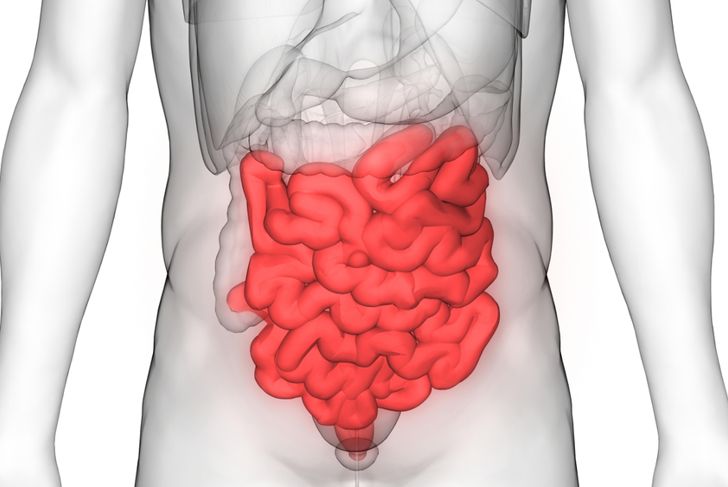Doctors diagnose an umbilical hernia when a portion of the intestine pokes through the umbilical opening — the belly button. A gestating baby draws nourishment from its mother through the umbilical cord before birth. After the doctor or partner severs the cord during the birth, the muscles at the baby’s umbilical opening should close. If they do not, an umbilical hernia could result. Although the condition is most common in infants, this type of hernia can occur later in life, for various reasons.
Common Symptoms of an Umbilical Hernia
Umbilical hernias are most common in premature or low birth-weight infants. Most umbilical hernias in infants naturally close by the age of five. Their most common symptom is a soft, smooth, bulging belly button. The hernia appears or becomes more prominent when the infant is straining, crying, or coughing, and could be unseen when she relaxes or rests on her back. For babies, umbilical hernias are usually painless, though in adults they often cause discomfort.
Common Causes in Adults
Although most umbilical openings close in early childhood, some do not seal completely, and this can contribute to an umbilical hernia later in life. Several health conditions can lead to adult umbilical hernias, including
- Constipation
- Multiple pregnancies
- Difficulty urination from an enlarged prostate gland
- Chronic coughing
- Repeated vomiting
- Excessive belly fluid
- Obesity
- Peritoneal dialysis for kidney failure
The strain of weightlifting or childbirth can also induce an umbilical hernia.
Treatment in Infants
Most cases of an umbilical hernia in infants resolve without treatment. Sometimes a doctor may massage or push the projection back into place. If the doctor determines the patient requires surgery, it is likely because the hernia continues to grow past one year of age or is still present at age four. Additionally, sometimes the intestines reside in the hernial sac and prevent proper movement, or the hernia becomes trapped.
Treatment in Adults
Umbilical hernias can be painful in adults and physicians often recommend surgery. Either laparoscopic or open surgery can push the bulge back in and strengthen the abdominal wall to prevent recurrence. In laparoscopic surgery, the surgeon passes mesh and sutures through a small keyhole incision. In open surgery, the doctor opens the site, uses mesh to strengthen the area, then stitches the muscles back together.
When to See a Doctor
Although, in infants, umbilical hernias are often minor conditions, parents should take their child to a doctor if he is in pain, is vomiting, or has swelling, tenderness, or discoloration at the hernia site. This advice should also be applied to adults with the condition. Prompt medical treatment can help prevent complications.
Complications
Complications occur when an umbilical hernia becomes strangulated, cutting off circulation to the entrapped intestine. Total blockage of the blood supply can damage the intestine and lead to infection or gangrene. The incidence of this is rare in adults and even more rare in children, but any signs of infection in a hernia should prompt a visit to a doctor.
Umbilical Hernia in Pregnancy
Umbilical hernias sometimes happen during pregnancy because the abdominal muscles are stretching to accommodate the growing uterus. A large baby or twins, previous abdominal surgery, being overweight, straining, or heavy lifting may all promote the condition. In most cases, umbilical hernias in pregnant women do not place the baby at risk.
Risks of Umbilical Hernia Repair Surgery
The risks of hernia surgery are low. Anyone with an additional medical condition can be at higher risk of complications during any surgery. Although rare, surgery to correct an umbilical hernia can injure the intra-abdominal structures or small intestine or cause blood clots or infection. As in any surgery, it is also possible for the patient to have an allergic reaction to the anesthesia.
How to Prepare for Umbilical Hernia Surgery
Surgeons usually perform umbilical hernia surgery using general anesthesia, so the patient does not feel any pain. Some hernias are repaired using a spinal block instead of anesthesia — the doctor applies the drug around the spinal cord rather than directly into the bloodstream, numbing the abdomen area. Usually, the surgeon will also administer pain relievers and sedatives. People taking NSAID medications will likely need to stop for a few days before surgery to prevent excessive bleeding, and fasting for at least six hours before surgery is standard, though the doctor will give specific instructions.
How Long is Surgical Recovery?
Immediately after surgery for a hernia, the patient will be given time to awaken fully while medical practitioners continue to monitor her vitals. This type of surgery is usually done on an outpatient basis, which means the hospital will release the patient the same day or the next morning. The doctor will prescribe painkillers and schedule a follow-up appointment. Most people can resume regular activities a few weeks after umbilical hernia surgery.

 Home
Home Health
Health Diet & Nutrition
Diet & Nutrition Living Well
Living Well More
More




















